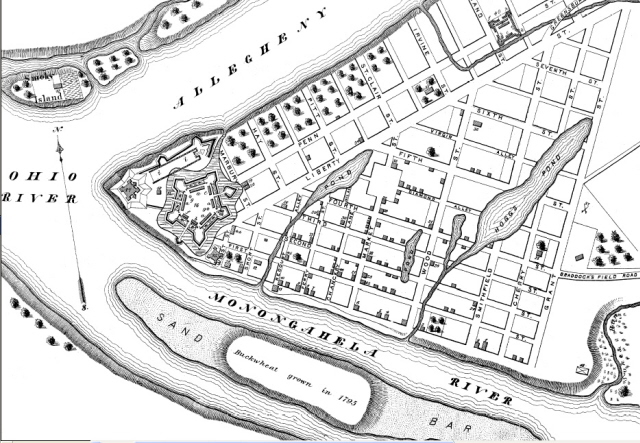Pittsburgh, though a hundred miles or so from the front lines and never directly threatened during the War of 1812, was vital to the war effort. Simply put, it was the "hub" from which supplies and most manufactured goods moved over the mountains separating the United States east coast from the interior of the continent were transshipped from horse-drawn Conestoga wagons and put onto boats to descend the Ohio and Mississippi Rivers. Most of these boats would have been the versatile and ubiquitous keel boats of Mike Fink fame. Fink himself was active on the Ohio and Miami Rivers about this time.

Fort Fayette in 1795 can be seen at the top right corner of this map of Pittsburgh. Fort Pitt is the large star shaped fort at the point, and the ruins of French Fort Duquesne lie at the very end of the point.
When the War of 1812 began, a torrent of supplies and equipment and even ordnance began moving through Pittsburgh. The iron industry was already in its infancy there, and was given a boost by military contracts for cannonballs and eventually the iron fittings for the squadron building at Erie, PA. The small Army post at Fort Fayette, about a mile from the confluence of the Allegheny and Monongahela rivers, which had replaced the old British Fort Pitt in 1792, became a center of bustling activity. The responsibility for making sure the supplies got to where they were needed devolved upon a junior officer of the 1st Regiment of Infantry, Hezekiah Johnson. Lt. Johnson seems to have been at odds with both General William Henry Harrison, who depended on him for supplies, and the teamsters who contracted to move the heavy army shipments. He also had to work with Major Amos Stoddard, who was the officer in charge of preparing ordnance and ammunition for the Northwestern Army to replace that lost at Detroit in August 1812. New Orleans and St. Louis were also supplied from this point. Because everything issued to the army in the west and south passed through this point, the surviving records (many of them penned by Lt. Johnson himself) offer a good picture of what kinds of equipment and clothing would have actually been available to the soldiers of 1812.
Fort Fayette was replaced by the Allegheny Arsenal in 1814, which continued to be an active US Army post through the Spanish American War.
No comments:
Post a Comment
Note: Only a member of this blog may post a comment.